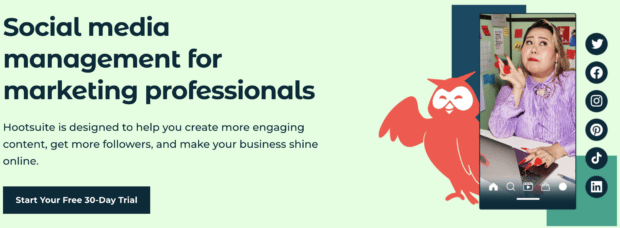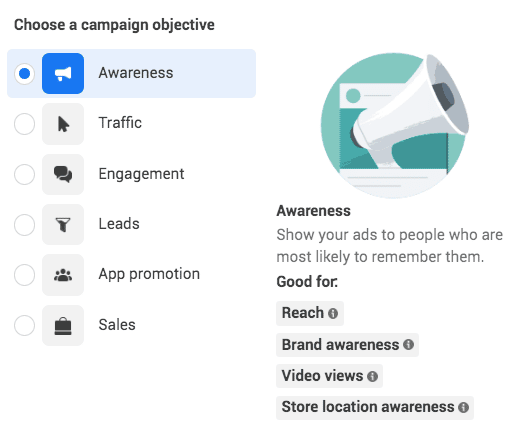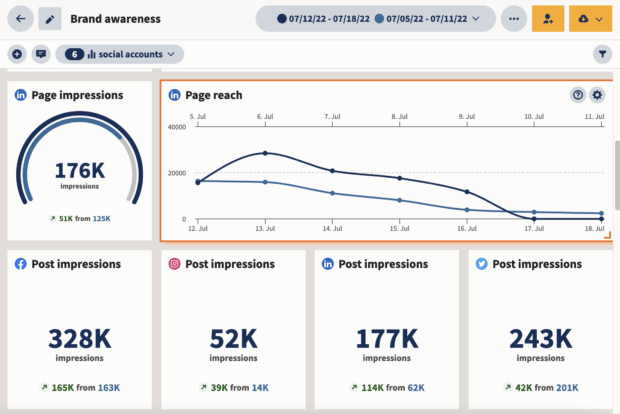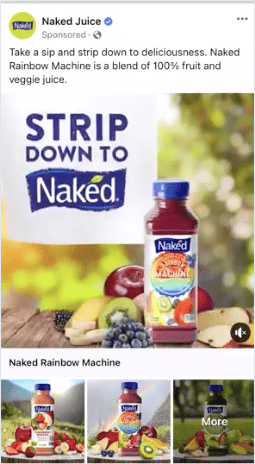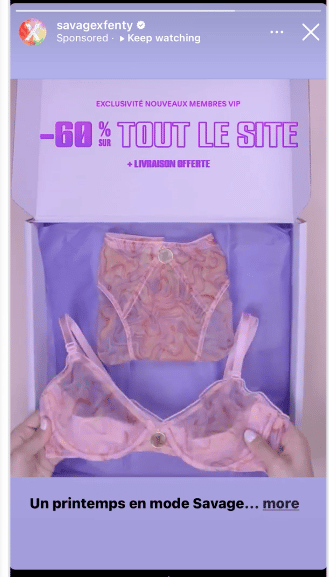9 Creative Ways to Improve Your Brand Awareness
Brand awareness: It’s one of those concepts you know you need to understand, but perhaps you find it somewhat… hard to pin down? You’re not alone.
On the surface, it’s simple. Brand awareness = people being aware of your brand. But how do you measure that? And what’s the exact brand awareness definition that makes sense for your business?
We explain everything you need to know about how to create an effective brand awareness strategy below.
Bonus: Get a free social media strategy template to quickly and easily plan your own strategy. Also use it to track results and present the plan to your boss, teammates, and clients.
What is brand awareness?
Brand awareness is a measure of how well people recognize your brand, including how “aware” they are that your brand exists at all. Rather than a simple individual metric, brand awareness is a concept that touches on many different KPIs, from traffic to social share of voice.
We’ll get into the details of how to measure brand awareness later in this post, but for now think of it as one indicator of brand health.
Why does brand awareness matter?
Strong brand awareness and brand recognition means your brand is top of mind when people think about the category of products or services you sell. They recognize your logo or tagline, making it easier to communicate effectively through social content, especially in images or short-form video.
Brand awareness is a required first step before building brand loyalty. After all, customers can’t love your brand until they know and recognize it.
Think about it as the difference between Coke and store-brand generic cola. No one’s wearing a T-shirt showing their love of generic cola. Sure, people buy it – usually because it’s the cheapest option. But no one is evangelizing for the generic brand.
The most valuable brands are usually the most recognizable. Nike is the most valuable apparel brand. Apple wins the consumer technology category. And, yes, Coca-Cola is tops in food and beverages.
You don’t need to reach the level of these behemoths to benefit from brand awareness, but there’s a lot you can model in the way these companies have built their brands.
How to increase brand awareness: 9 tactics
1. Build a recognizable brand
Brand building is an important first step for brand awareness. That means you need to have a clear idea of what your brand is and what it represents. What does your brand look like? Sound like? Stand for?
Some key components to a recognizable brand include:
Brand voice
What kind of tone do you use? Are you formal or casual? Cheeky or serious? Playful or businessy?
You don’t need to use exactly the same tone in every format. Your brand voice on social media might be more light-hearted and fun than the voice you use in, say, print ads. Your voice might even shift a little from Facebook to TikTok.
But the way you speak to customers and about your product should ultimately be recognizable across channels. Choose some consistent key words and phrases and follow your style guide.
Brand aesthetic
Consistency is key to brand building and brand awareness. That’s true for your look as well as your words.
What are your brand colors? Fonts? What is your overall look on visual platforms like Instagram and TikTok?
For example, look at these Instagram posts from Old Navy, Banana Republic, and The Gap. All three brands are owned by the same company, but each targets a different demographic, with a social aesthetic to match.
Brand values
We’ve talked about defining what you look and sound like. But brand values define who you are as a brand. Having a clear set of brand values is the most important component of building a recognizable brand.
Don’t get hung up on your ideas of what values have to be. This isn’t all about doing charity work or making corporate donations (although those can certainly be aspects of how you live your brand values). This is more about defining what you stand for as a brand and how you embody that in your interactions with everyone from customers to employees.
Make sure your brand values align with those of your target audience. According to the Edelman Trust Barometer, 58% of consumers buy or advocate for brands based on their beliefs and values, while 60% of employees use beliefs and values to choose their employer.
This is not about lip service. What you do is at least as important as what you say.
Source: 2022 Edelman Trust Barometer Special Report: the New Cascade of Influence
Logo and tagline
You could argue these are part of your brand voice and aesthetic, but they’re important enough they deserve to be called out on their own. These are the instantly recognizable representations of your brand.
If you read “Just Do It” or see the iconic swoosh, you don’t need anyone to tell you you’re looking at a Nike product or ad. Red Bull gives you what? (Say it with me now: Wings.) Put some thought into these aspects of your brand, as they’ll become the currency of your brand.
Source: Nike on Facebook
2. Tell a brand story
This correlates to some of the elements we’ve already talked about, but it goes a little further than your brand values and voice. Your brand story is the narrative of your brand and how it got to be that way.
For an entrepreneur, the brand story might be that they spotted a problem in their day job and invented a solution to fix the problem.
@crystalangel__ Scrubs @angelwearclothing #medicalscrubs #nursesoftiktok #cna #rn #nurselife #scrublife #healthcare #scrubhaul #nurse #smallbusinesstiktok #blackownedbusiness #blackgirltiktok #girlboss
For a larger business, your brand story might be a conglomeration of your mission statement and your history.
Every brand has a story. But the critical component for brand awareness is to tell that story. Use narrative to showcase your brand story through, for example, customer experiences, or by marking key milestones in your growth.
For example, Harley-Davidson produces The Enthusiast magazine, which showcases rider stories as well as riding tips and information about new models and gear. Rider stories also feature on their social channels:
3. Create value beyond your product
A key way to build long-term brand awareness is to create value beyond your product. Think about ways you can inform, educate, or entertain.
Do you or your team have specialized expertise? Don’t keep it to yourselves! Share your knowledge through a blog, podcast, YouTube channel, or newsletter.
This shouldn’t be about making sales directly. Instead, this is a relationship-building and brand awareness practice that creates more opportunities for audiences to get to know your brand.
For example, Patagonia creates films that align with their brand values and story. Their products appear in the films, but there is no hard sell. The value is in the films themselves. The webpage where the films live says, “We are a collective of storytellers who make films on behalf of our home planet.”
4. Create shareable content
This overlaps a little bit with the last couple of points, but here we’re focused specifically on creating content that’s easy to share. While it’s not always possible to predict what will go viral, you can certainly take steps to make your content more discoverable and shareable.
First, you should follow social media optimization best practices like posting consistently and at the right time.
But also create content that your followers will want to share. This aligns with the idea of providing value in your content rather than always trying to make a sale. Try adding a call to action that suggests sharing your resources or tagging a friend.
Also make your content easy to share with social sharing buttons on your website and blog, which can help provide social proof.
5. Contribute to your community
Not all brand-building happens online. You can establish brand awareness by contributing to your community in concrete ways like sponsoring events, offering corporate donations, or facilitating employees’ participation in charity work.
This can be as big as the sponsorship of a major event, like Vancouver’s annual fireworks competition, known as the Honda Celebration of Light
Or it could be as simple as contributing an item to a silent auction for a local fundraiser.
6. Offer a freebie
Everyone loves a freebie. Offering something for free is a good way to get skeptical potential customers to try your product. It can also create buzz about your brand online.
Whether it’s a free sample, a free trial or a “freemium” business model, a free taste of what you offer helps get people in the door and spreads awareness of your brand.
What’s the difference between a free trial and freemium?
In a free trial, you offer all or a version of your regular product or service for free for a limited time – usually 7, 14, or 30 days.
With a freemium business model, you offer a basic version of your product for free indefinitely with the option to upgrade to a paid plan for more advanced features.
For example, Hootsuite offers a limited free plan and a 30-day free trial on the professional plan.
Source: Hootsuite Professional
7. Run social media contests
The point above is all about creating brand awareness by making it easy for people to try your product or service. This point also involves free stuff, but here it’s about using a giveaway to draw attention to your brand on social media.
The “tag-a-friend” entry model of social contests is a particularly good way to get new eyeballs to your social accounts and in turn raise awareness of your brand. If you collaborate with another brand or content creator, you’ll increase your potential new audience size even more.
8. Work with the social algorithms
Instagram may have backed off its recommended content algorithm changes for now, but it nonetheless looks like recommended content is here to stay on Meta platforms. Mark Zuckerberg emphasized this in the latest earnings call:
“Right now, about 15% of content in a person’s Facebook feed and a little more than that of their Instagram feed is recommended by our AI from people, groups, or accounts that you don’t follow. We expect these numbers to more than double by the end of next year.”
And, of course, recommended content on the FYP is the driving force on TikTok.
Recommended content increases the opportunities for discovery on social platforms, as your content is seen by users who don’t yet follow you. That extra exposure is a good way to increase brand awareness.
Bonus: Get a free social media strategy template to quickly and easily plan your own strategy. Also use it to track results and present the plan to your boss, teammates, and clients.
Get the template now!But as Instagram learned when it leaned too hard into recommended content, people only like what they like. Basically, having your content show up in users’ feeds is only part of the equation. To generate real brand awareness, you have to create content they actually want to see.
We’ve got full blog posts on how to work with each of the social platforms’ algorithms, if you want to dive into this social media marketing strategy:
- Instagram algorithm (TL;DR: Reels. Reels. And more Reels.)
- Facebook algorithm
- Tiktok algorithm
- Twitter algorithm
To make sure the content you create is actually valuable to your potential audience, you’ve also got to understand who that audience is. For more details, check out our post on how to find your target market.
9. Run awareness ads
The social networks all know that brand awareness is a key business goal for many brands using their tools, which is why they offer ads that specifically focus on awareness.
Which targeting option is best for achieving brand awareness? The specific label may vary by platform, but it will always be called something like Awareness, Brand Awareness, or Reach.
Source: Meta Ads Manager
Here’s how Meta describes the brand awareness objective for ads on their platforms:
“The brand awareness objective is for advertisers who want to show ads to people who are more likely to recall them.
The brand awareness objective gives you the estimated ad recall lift (people) metric, which shows how many people we estimate would remember your ad if we asked them within two days.”
LinkedIn puts it a little more simply: “Tell more people about your products, services, or organization by selecting the Brand Awareness objective for your ad campaigns.”
Meanwhile, TikTok calls its branded hashtag challenge ad format the “master of mass awareness” and one of the “biggest and best ad formats for widespread and unmissable awareness.”
In short, brand awareness ads are a straightforward way to ensure your social advertising budget goes toward building awareness for your brand.
How to measure brand awareness
As we said right up at the top, brand awareness is not a single metric. But there are a number of stats you can use to measure it. Here are some of the most important brand awareness metrics and how to track them.
Note that while each of the social platforms offers its own analytics tools, those give you a siloed picture of your results one account at a time. For an overall view of your brand awareness success, it’s important to look at all the platforms together.
An analytics dashboard like Hootsuite Analytics makes measuring brand awareness metrics much easier by tracking data from all your social accounts in one place with the ability to create custom graphical reports that help you see changes in brand awareness over time.
Try Hootsuite for free. Cancel anytime.
Reach
Reach indicates the number of people who see your social content. When more people see your content, more people are likely to start to recognize what differentiates you as a brand. (This is why it’s so important to have a consistent brand voice and aesthetic.
When tracking your reach as a measure of brand awareness, pay special attention to the number of followers and non-followers.
Non-followers who see your content are potentially being exposed to your brand for the first time, generating new awareness.They’re seeing your content because it was recommended to them, either by one of their social contacts or by a social algorithm.
Impressions
As noted above, reach measures the number of people who saw your content (or, more specifically, the number of accounts that saw your content). By contrast, impressions measures the number of times people saw your content.
If your number of impressions is significantly higher than your reach, people are looking at your content multiple times. This can be a great signal of brand awareness. After all, the more times someone looks at a single piece of content, the more likely they are to remember the brand behind it.
Audience growth rate
Audience growth rate measures how quickly your audience is growing. This provides great signals of brand awareness, as followers are certainly more likely to know about and recognize your brand than are people who don’t yet follow you.
To calculate audience growth rate, take your number of new followers over a certain period and divide it by your total existing followers. Then, multiple by 100 to get your audience growth rate as a percentage.
Social share of voice
Social share of voice is a good way to measure awareness of your brand compared to your competitors. It indicates how much of the social conversation in your industry is dedicated to your brand.
To calculate social share of voice:
- Tally all the mentions of your brand across social networks – both tagged and untagged. (A social listening tool like Hootsuite is extremely helpful here.)
- Do the same for your key competitors.
- Add both sets of mentions together to get a total number of mentions for your industry.
- Divide your mentions by the total.
- Multiply by 100 to get a percentage.
Direct traffic
Direct traffic is an indication of how many people land on your website by typing in your website address directly. (As opposed to finding you through a search engine, social channel, and so on.)
If someone knows your URL, they’re pretty clearly aware of your brand.
Using a web analytics tool like Google Analytics, you can see how people find your website online. Look for the direct traffic information to see how many people are typing your URL directly into their browsers.
3 examples of brand awareness campaigns on social media
1. The Balvenie
The Balvenie Whisky brand awareness campaign featured a YouTube web series in partnership with Questlove. The series featured meaningful interviews with celebrity creatives and thinkers, while raising awareness for the brand.
Quest for Craft: Season 1 | Series Trailer
The marketing campaign brought in 5.1 thousand new YouTube subscribers and raised key brand awareness attributes above the relevant benchmarks.
2. Naked Juice
Naked Juice used Facebook and Instagram video and photo collection format ads with the reach objective for its brand awareness campaign. The ads, which appeared in both feed and Stories, used strong imagery and large text overlay to raise brand awareness with or without sound.
Source: Facebook
The campaign saw a 3.7 point lift in brand awareness.
3. Savage X Fenty
Savage X Fenty used brand awareness ad objectives to reach new audiences on Facebook and Instagram. The awareness ads focused specifically on creating a strong sense of brand, with sales or offers as a secondary focus.
Targeting all women in France, Savage X Fenty created half the ads themselves, and partnered with a group of Instagram influencers to create the rest.
Source: Instagram
These brand awareness ads resulted in a 6.9 point increase in ad recall.
Measure brand awareness and reach your target audience with Hootsuite. Publish your posts and analyze the results in the same, easy-to-use dashboard. Try it free today
All your social media analytics in one place. Use Hootsuite to see what’s working and where to improve performance.
Free 30-Day TrialThe post 9 Creative Ways to Improve Your Brand Awareness appeared first on Social Media Marketing & Management Dashboard.
Categories
- 60% of the time… (1)
- A/B Testing (2)
- Ad placements (3)
- adops (4)
- adops vs sales (5)
- AdParlor 101 (43)
- adx (1)
- algorithm (1)
- Analysis (9)
- Apple (1)
- Audience (1)
- Augmented Reality (1)
- authenticity (1)
- Automation (1)
- Back to School (1)
- best practices (2)
- brand voice (1)
- branding (1)
- Build a Blog Community (12)
- Case Study (3)
- celebrate women (1)
- certification (1)
- Collections (1)
- Community (1)
- Conference News (1)
- conferences (1)
- content (1)
- content curation (1)
- content marketing (1)
- contests (1)
- Conversion Lift Test (1)
- Conversion testing (1)
- cost control (2)
- Creative (6)
- crisis (1)
- Curation (1)
- Custom Audience Targeting (4)
- Digital Advertising (2)
- Digital Marketing (6)
- DPA (1)
- Dynamic Ad Creative (1)
- dynamic product ads (1)
- E-Commerce (1)
- eCommerce (2)
- Ecosystem (1)
- email marketing (3)
- employee advocacy program (1)
- employee advocates (1)
- engineers (1)
- event marketing (1)
- event marketing strategy (1)
- events (1)
- Experiments (21)
- F8 (2)
- Facebook (64)
- Facebook Ad Split Testing (1)
- facebook ads (18)
- Facebook Ads How To (1)
- Facebook Advertising (30)
- Facebook Audience Network (1)
- Facebook Creative Platform Partners (1)
- facebook marketing (1)
- Facebook Marketing Partners (2)
- Facebook Optimizations (1)
- Facebook Posts (1)
- facebook stories (1)
- Facebook Updates (2)
- Facebook Video Ads (1)
- Facebook Watch (1)
- fbf (11)
- first impression takeover (5)
- fito (5)
- Fluent (1)
- Get Started With Wix Blog (1)
- Google (9)
- Google Ad Products (5)
- Google Analytics (1)
- Guest Post (1)
- Guides (32)
- Halloween (1)
- holiday marketing (1)
- Holiday Season Advertising (7)
- Holiday Shopping Season (4)
- Holiday Video Ads (1)
- holidays (4)
- Hootsuite How-To (3)
- Hootsuite Life (1)
- how to (5)
- How to get Instagram followers (1)
- How to get more Instagram followers (1)
- i don't understand a single thing he is or has been saying (1)
- if you need any proof that we're all just making it up (2)
- Incrementality (1)
- influencer marketing (1)
- Infographic (1)
- Instagram (39)
- Instagram Ads (11)
- Instagram advertising (8)
- Instagram best practices (1)
- Instagram followers (1)
- Instagram Partner (1)
- Instagram Stories (2)
- Instagram tips (1)
- Instagram Video Ads (2)
- invite (1)
- Landing Page (1)
- link shorteners (1)
- LinkedIn (22)
- LinkedIn Ads (2)
- LinkedIn Advertising (2)
- LinkedIn Stats (1)
- LinkedIn Targeting (5)
- Linkedin Usage (1)
- List (1)
- listening (2)
- Lists (3)
- Livestreaming (1)
- look no further than the new yorker store (2)
- lunch (1)
- Mac (1)
- macOS (1)
- Marketing to Millennials (2)
- mental health (1)
- metaverse (1)
- Mobile App Marketing (3)
- Monetizing Pinterest (2)
- Monetizing Social Media (2)
- Monthly Updates (10)
- Mothers Day (1)
- movies for social media managers (1)
- new releases (11)
- News (72)
- News & Events (13)
- no one knows what they're doing (2)
- OnlineShopping (2)
- or ari paparo (1)
- owly shortener (1)
- Paid Media (2)
- People-Based Marketing (3)
- performance marketing (5)
- Pinterest (34)
- Pinterest Ads (11)
- Pinterest Advertising (8)
- Pinterest how to (1)
- Pinterest Tag helper (5)
- Pinterest Targeting (6)
- platform health (1)
- Platform Updates (8)
- Press Release (2)
- product catalog (1)
- Productivity (10)
- Programmatic (3)
- quick work (1)
- Reddit (3)
- Reporting (1)
- Resources (34)
- ROI (1)
- rules (1)
- Seamless shopping (1)
- share of voice (1)
- Shoppable ads (4)
- Skills (28)
- SMB (1)
- SnapChat (28)
- SnapChat Ads (8)
- SnapChat Advertising (5)
- Social (169)
- social ads (1)
- Social Advertising (14)
- social customer service (1)
- Social Fresh Tips (1)
- Social Media (5)
- social media automation (1)
- social media content calendar (1)
- social media for events (1)
- social media management (2)
- Social Media Marketing (49)
- social media monitoring (1)
- Social Media News (4)
- social media statistics (1)
- social media tracking in google analytics (1)
- social media tutorial (2)
- Social Toolkit Podcast (1)
- Social Video (5)
- stories (1)
- Strategy (601)
- terms (1)
- Testing (2)
- there are times ive found myself talking to ari and even though none of the words he is using are new to me (1)
- they've done studies (1)
- this is also true of anytime i have to talk to developers (1)
- tiktok (8)
- tools (1)
- Topics & Trends (3)
- Trend (12)
- Twitter (15)
- Twitter Ads (5)
- Twitter Advertising (4)
- Uncategorised (9)
- Uncategorized (13)
- url shortener (1)
- url shorteners (1)
- vendor (2)
- video (10)
- Video Ads (7)
- Video Advertising (8)
- virtual conference (1)
- we're all just throwing mountains of shit at the wall and hoping the parts that stick don't smell too bad (2)
- web3 (1)
- where you can buy a baby onesie of a dog asking god for his testicles on it (2)
- yes i understand VAST and VPAID (1)
- yes that's the extent of the things i understand (1)
- YouTube (13)
- YouTube Ads (4)
- YouTube Advertising (9)
- YouTube Video Advertising (5)

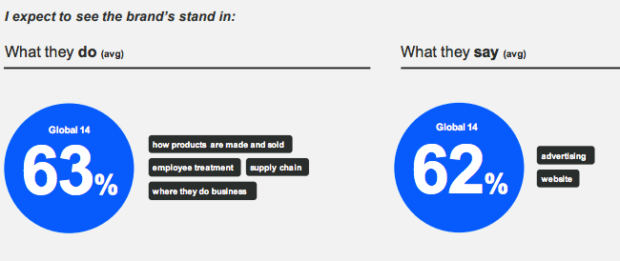
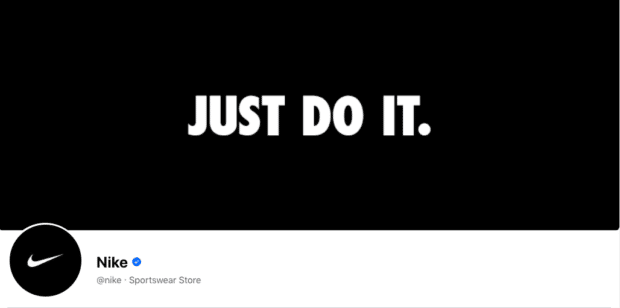
 Zurich Food Guide (@swissfoodstagram)
Zurich Food Guide (@swissfoodstagram)